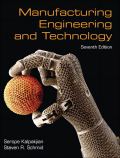
EBK MANUFACTURING ENGINEERING & TECHNOL
7th Edition
ISBN: 8220100793431
Author: KALPAKJIAN
Publisher: PEARSON
expand_more
expand_more
format_list_bulleted
Concept explainers
Textbook Question
Chapter 4, Problem 26QLP
Why is it important to know the characteristics of heat-treating furnaces? Explain.
Expert Solution & Answer
Want to see the full answer?
Check out a sample textbook solution
Students have asked these similar questions
my ID# 016948724. Please solve this problem step by step
My ID# 016948724 please find the forces for Fx=0: fy=0: fz=0: please help me to solve this problem step by step
My ID# 016948724 please solve the proble step by step find the forces fx=o: fy=0; fz=0; and find shear moment and the bending moment diagran please draw the diagram for the shear and bending moment
Chapter 4 Solutions
EBK MANUFACTURING ENGINEERING & TECHNOL
Ch. 4 - Describe the difference between a solute and a...Ch. 4 - What is a solid solution?Ch. 4 - Prob. 3RQCh. 4 - Describe the difference between a single-phase and...Ch. 4 - What is an induction heater? What kind of part...Ch. 4 - Describe the major features of a phase diagram.Ch. 4 - What do the terms equilibrium and constitutional,...Ch. 4 - Prob. 8RQCh. 4 - What is tempering? Why is it performed?Ch. 4 - Explain what is meant by severity of quenching.
Ch. 4 - What are precipitates? Why are they significant in...Ch. 4 - Prob. 12RQCh. 4 - Prob. 13RQCh. 4 - Prob. 14RQCh. 4 - Prob. 15RQCh. 4 - You may have seen some technical literature on...Ch. 4 - Prob. 17QLPCh. 4 - What is the difference between hardness and...Ch. 4 - Prob. 19QLPCh. 4 - Prob. 20QLPCh. 4 - Prob. 21QLPCh. 4 - Describe the characteristics of (a) an alloy, (b)...Ch. 4 - Explain why carbon, among all elements, is so...Ch. 4 - Prob. 24QLPCh. 4 - In Section 4.8.2, several fluids are listed in...Ch. 4 - Why is it important to know the characteristics of...Ch. 4 - Explain why, in the abscissa of Fig. 4.16c, the...Ch. 4 - Prob. 28QLPCh. 4 - Prob. 29QLPCh. 4 - Prob. 30QLPCh. 4 - Design a heat-treating cycle for carbon steel,...Ch. 4 - Using Fig. 4.4, estimate the following quantities...Ch. 4 - Prob. 33QTPCh. 4 - Prob. 34QTPCh. 4 - Prob. 35SDPCh. 4 - Figure 4.18b shows hardness distributions in...Ch. 4 - Throughout this chapter, you have seen specific...Ch. 4 - Refer to Fig. 4.24, and think of a variety of...Ch. 4 - Inspect various parts in your car or home, and...
Knowledge Booster
Learn more about
Need a deep-dive on the concept behind this application? Look no further. Learn more about this topic, mechanical-engineering and related others by exploring similar questions and additional content below.Similar questions
- My ID#016948724 please solve this problems and show me every step clear to follow pleasearrow_forwardMy ID# 016948724arrow_forwardPlease do not use any AI tools to solve this question. I need a fully manual, step-by-step solution with clear explanations, as if it were done by a human tutor. No AI-generated responses, please.arrow_forward
- Please do not use any AI tools to solve this question. I need a fully manual, step-by-step solution with clear explanations, as if it were done by a human tutor. No AI-generated responses, please.arrow_forwardPlease do not use any AI tools to solve this question. I need a fully manual, step-by-step solution with clear explanations, as if it were done by a human tutor. No AI-generated responses, please.arrow_forward[Q2]: The cost information supplied by the cost accountant is as follows:Sales 20,00 units, $ 10 per unitCalculate the (a/ newsale guantity and (b) new selling price to earn the sameVariable cost $ 6 per unit, Fixed Cost $ 30,000, Profit $ 50,000profit ifi) Variable cost increases by $ 2 per unitil) Fixed cost increase by $ 10,000Ili) Variable cost increase by $ 1 per unit and fixed cost reduces by $ 10,000arrow_forward
- can you please help me perform Visual Inspection and Fractography of the attatched image: Preliminary examination to identify the fracture origin, suspected fatigue striation, and corrosion evidences.arrow_forwardcan you please help[ me conduct Causal Analysis (FTA) on the scenario attatched: FTA diagram which is a fault tree analysis diagram will be used to gain an overview of the entire path of failure from root cause to the top event (i.e., the swing’s detachment) and to identify interactions between misuse, material decay and inspection errors.arrow_forwardhi can you please help me in finding the stress intensity factor using a k-calcluator for the scenario attathced in the images.arrow_forward
arrow_back_ios
SEE MORE QUESTIONS
arrow_forward_ios
Recommended textbooks for you
 Welding: Principles and Applications (MindTap Cou...Mechanical EngineeringISBN:9781305494695Author:Larry JeffusPublisher:Cengage Learning
Welding: Principles and Applications (MindTap Cou...Mechanical EngineeringISBN:9781305494695Author:Larry JeffusPublisher:Cengage Learning

Welding: Principles and Applications (MindTap Cou...
Mechanical Engineering
ISBN:9781305494695
Author:Larry Jeffus
Publisher:Cengage Learning
Physics - Thermodynamics: (21 of 22) Change Of State: Process Summary; Author: Michel van Biezen;https://www.youtube.com/watch?v=AzmXVvxXN70;License: Standard Youtube License